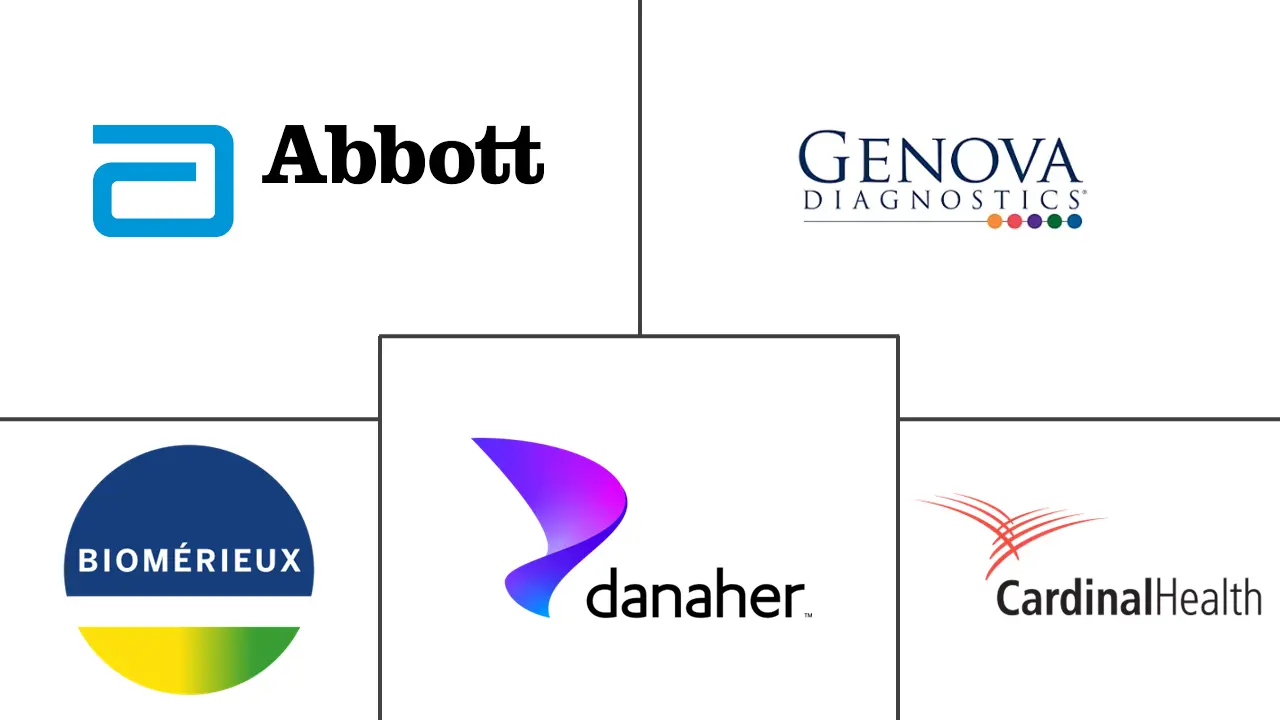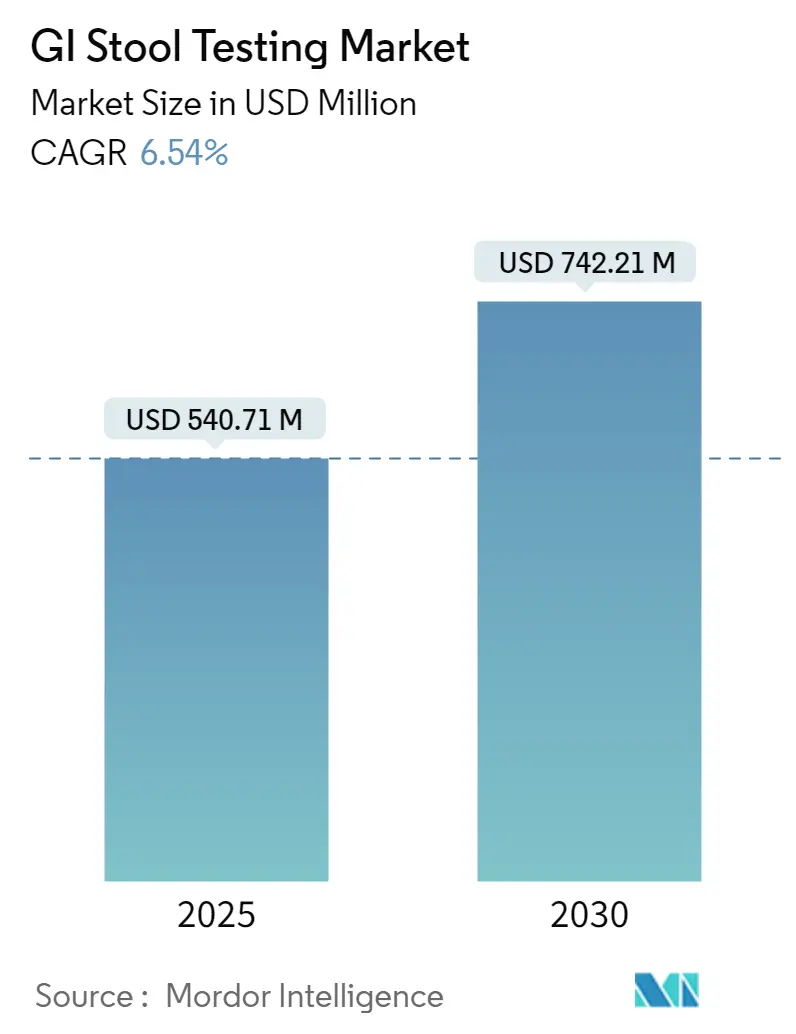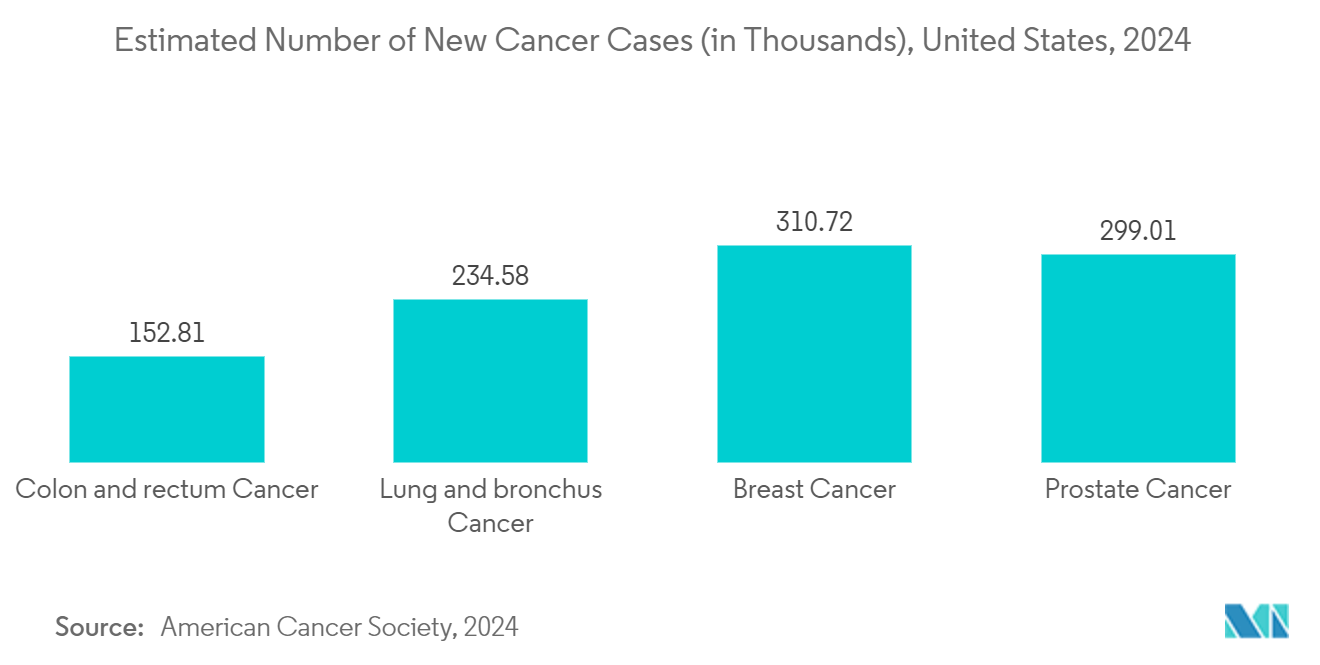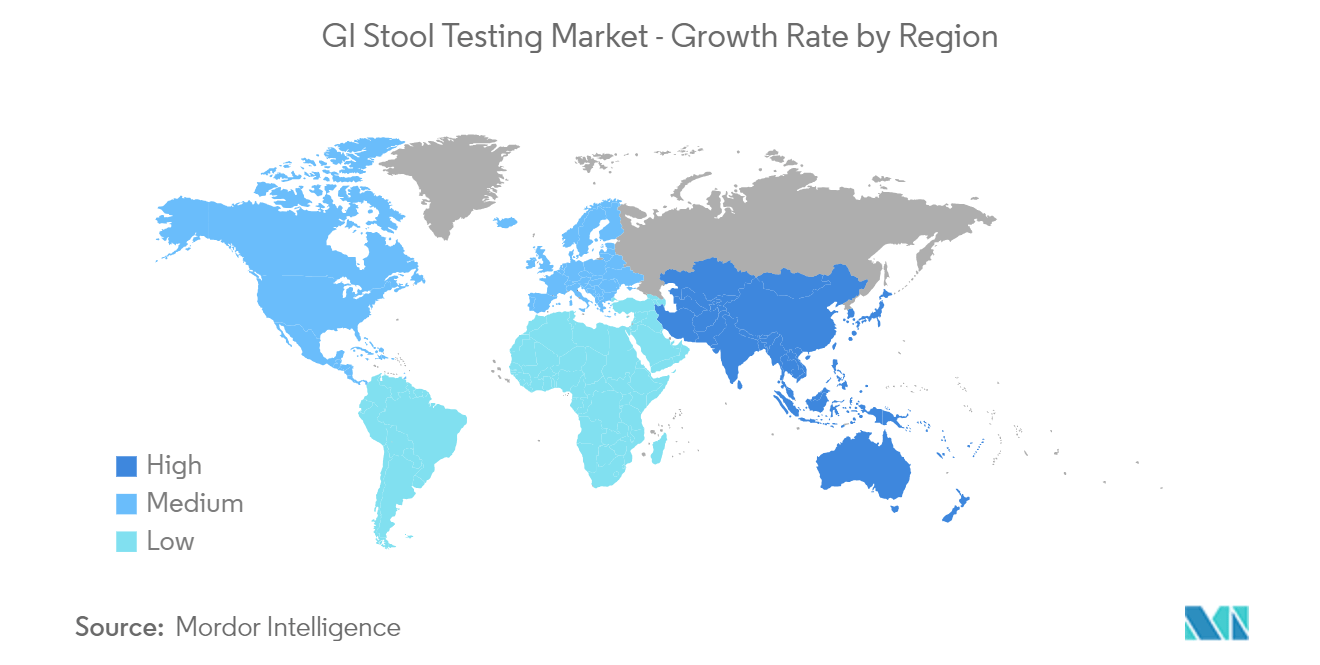GI Stool Testing Market Analysis
The GI Stool Testing Market size is estimated at USD 540.71 million in 2025, and is expected to reach USD 742.21 million by 2030, at a CAGR of 6.54% during the forecast period (2025-2030).
Factors such as the growing burden of gastrointestinal diseases and rising preference for point-of-care tests are boosting the market growth.
In recent years, the rate of diagnosis for gastrointestinal infections has increased, propelling the market's growth. For instance, according to a report published by the Bower Cancer UK in February 2024 showed that bowel cancer is the fourth most common cancer, and approximately 43,000 people are diagnosed with bowel cancer every year in the United Kingdom. This is expected to increase the demand for stool DNA testing, which is used to screen for colon cancer in people with no symptoms, propelling the market growth.
Additionally, according to a report published by the Cureus Journal in January 2024, globally, hemorrhoids affect approximately 50% to 85% of the population, impacting individuals of all genders and across all age groups. Moreover, the report mentioned that in Northwest Ethiopia, 13.1% of patients visiting the surgical outpatient department were affected by hemorrhoids. The risk of having hemorrhoids was shown to be higher in people who were overweight and had constipation problems. Thus, the high prevalence of hemorrhoids among the population is anticipated to increase the need for a fecal occult blood test to detect the disease and hence boost the market growth early.
Also, the rising product launches increase the availability of stool testing kits and products in the market, which is anticipated to fuel market growth. For instance, in June 2022, Prenetics Group Limited, one of the global leaders in genomic and diagnostic testing, launched a novel, non-invasive, at-home screening test, ColoClear by Circle (ColoClear), for detecting early signs of colorectal cancer in Hong Kong.
Therefore, the market is expected to grow during the forecast period due to the high burden of gastric cancer and other related diseases. However, the high cost of instruments is expected to impede the growth of the GI stool testing market during the forecast period.
GI Stool Testing Market Trends
The Reagent Segment is Expected to Witness Significant Growth in the GI Stool Testing Market During the Forecast Period
The reagent segment is expected to witness significant growth in the GI stool testing market during the forecast period owing to factors such as the rising prevalence of gastrointestinal diseases and irritable bowel syndrome and GERD, as well as the increasing demand for early detection of the diseases.
Reagents are substances often used for examining and analyzing. With the development of diagnostic technology, agents are expected to dominate the GI stool testing market. Chemiluminant assays are used as a diagnostic aid for the detection of gastrointestinal infections. They use enzyme-labeled antibodies for detection, which is known to give an accurate diagnosis.
For instance, according to an article published in Microorganisms in June 2022, microscopic examination of feces is still a common method for diagnosing intestinal parasite infections, which necessitates the use of reliable reagents and qualified personnel. In addition, as per the same source, the ready-to-use concentration methods for detecting parasite eggs in the ParaFlo tests (Eurobio Ingen) are expected to improve reagent traceability and manipulation ease. This is anticipated to boost the demand for reagents for detecting various gastrointestinal diseases, hence propelling segment growth.
Stool testing is also beneficial for the early diagnosis of colon cancer, which is expected to propel segment growth. For instance, as per an article published in the Clinical and Translational Gastroenterology in April 2022, the multitarget stool DNA test with fecal immunochemical test (sDNA-FIT) is recommended as a potential approach for colorectal cancer screening in people aged 45 years and above and for those who are at average risk, in all significant United States guidelines. The sDNA-FIT analyzes 11 biomarkers, including human hemoglobin, NDRG4, and BMP3 aberrant methylation, KRAS point mutations, NDRG4 and BMP3 point mutations, and human hemoglobin. Hence, adopting stool testing for various GI-related diseases is anticipated to boost the market growth.
Moreover, in June 2022, Meridian Bioscience Inc. launched two new sample-specific master mixes: Lyo-Ready Direct DNA qPCR Stool Mix and Lyo-Ready Direct RNA/DNA qPCR Stool Mix. These innovative master mixes improve the molecular detection of DNA and RNA from crude fecal specimens while allowing room-temperature stabilization of the diagnostic assay.
Therefore, owing to factors such as the rising research studies and increasing adoption of reagents in stool testing, the segment is expected to grow during the forecast period.
North America is Expected to Hold a Significant Share in the Market and is Expected to Witness the Same Over the Forecast Period
North America is expected to hold a significant share of the market and witness the same during the forecast period owing to factors such as a higher incidence of gastrointestinal diseases like colorectal cancer. For instance, according to 2023 statistics published by the ACS, about 106,970 new cases of colon cancer and 46,050 new cases of rectal cancer are expected to be diagnosed in the United States in 2023.
Also, as per an article published in the National Library of Medicine (NLM) in July 2022, gastroesophageal reflux disease (GERD) is one of the most widespread gastrointestinal conditions, affecting 20% of adults in Western countries such as the United States. In addition, the estimated prevalence of GERD in the US population ranges from 18.1% to 27.8%. Also, per the data published by the Canadian Cancer Society, in May 2022, colorectal cancer was expected to be the fourth most diagnosed cancer in Canada. Nearly 24,300 Canadians were diagnosed with colorectal cancer, which represented 10% of all new cancer cases in Canada in 2022.
Also, the growing company activities in developing innovative test kits and increasing product launches are contributing to market growth. For instance, in January 2023, Geneoscopy submitted a premarket approval application to the FDA for its stool-based colorectal cancer screening test. Such initiatives may lead to the introduction of new products in the near future, thus driving the market's growth.
Therefore, owing to factors such as the rising burden of colon cancer and GERD among the population and increasing product launches, the market is anticipated to augment its growth during the forecast period.
GI Stool Testing Industry Overview
The GI stool testing market is fragmented in nature, with the presence of major players in the market. Collaborations, mergers, and acquisitions by companies related to GI stool testing are expected to boost market growth. Some of the companies which are currently dominating the GI stool testing market are bioMérieux SA, DiaSorin SpA, Cenegenics Corporation, Abbott Laboratories, Epitope Diagnostics Inc., Genova Diagnostics, Danaher Corporation (Beckman Coulter Inc.), ScheBo Biotech AG, CTKBiotech Inc. Inc., and Cardinal Health.
GI Stool Testing Market Leaders
-
Abbott Laboratories
-
Genova Diagnostics
-
bioMérieux SA
-
Cardinal Health
-
Danaher Corporation (Beckman Coulter, Inc.)
- *Disclaimer: Major Players sorted in no particular order
GI Stool Testing Market News
- June 2024: QIAGEN launched its QIAstat-Dx Gastrointestinal Panel 2 in the United States. The panel leverages QIAstat-Dx’s ability to quickly multiply many genetic targets using real-time PCR technology in the same reaction, an important advance compared to traditional microbiological testing, which often requires samples to be incubated for at least 24 hours and up to 10 days of specimen collection.
- January 2024: ELITechGroup launched its GI Bacterial PLUS ELITe MGB Kit. It is tailored specifically for diagnosing gastrointestinal bacterial infections, the in vitro assay exclusively targets major bacterial pathogens, including Campylobacter spp., Clostridium difficile, Salmonella spp., Shigella spp., and Yersinia enterocolitica.
GI Stool Testing Industry Segmentation
As per the scope of the report, gastrointestinal infection testing involves the detection and analysis of any pathogens in the digestive tract using the stool as a sample. The gastrointestinal infection testing market is segmented by product type, test type, and geography. The product type segment is further segmented into instrument and reagent. The test type segment is further divided into occult blood test, ova and parasites test, bacteria test, fecal biomarkers test, and other test types. By geography, the market is segmented into North America, Europe, Asia-Pacific, Middle East and Africa, and South America. The market report also covers the estimated market sizes and trends for 17 countries across major regions globally. The report offers the value (in USD) for the above segments.
| By Product Type | Instruments | ||
| Reagents | |||
| By Test Type | Occult Blood Test | ||
| Ova and Parasites Test | |||
| Bacteria Test | |||
| Fecal Biomarkers Test | |||
| Other Test Types | |||
| Geography | North America | United States | |
| Canada | |||
| Mexico | |||
| Europe | Germany | ||
| United Kingdom | |||
| France | |||
| Italy | |||
| Spain | |||
| Rest of Europe | |||
| Asia-Pacific | China | ||
| Japan | |||
| India | |||
| Australia | |||
| South Korea | |||
| Rest of Asia-Pacific | |||
| Middle East and Africa | GCC | ||
| South Africa | |||
| Rest of Middle East and Africa | |||
| South America | Brazil | ||
| Argentina | |||
| Rest of South America | |||
GI Stool Testing Market Research FAQs
How big is the GI Stool Testing Market?
The GI Stool Testing Market size is expected to reach USD 540.71 million in 2025 and grow at a CAGR of 6.54% to reach USD 742.21 million by 2030.
What is the current GI Stool Testing Market size?
In 2025, the GI Stool Testing Market size is expected to reach USD 540.71 million.
Who are the key players in GI Stool Testing Market?
Abbott Laboratories, Genova Diagnostics, bioMérieux SA, Cardinal Health and Danaher Corporation (Beckman Coulter, Inc.) are the major companies operating in the GI Stool Testing Market.
Which is the fastest growing region in GI Stool Testing Market?
Asia Pacific is estimated to grow at the highest CAGR over the forecast period (2025-2030).
Which region has the biggest share in GI Stool Testing Market?
In 2025, the North America accounts for the largest market share in GI Stool Testing Market.
What years does this GI Stool Testing Market cover, and what was the market size in 2024?
In 2024, the GI Stool Testing Market size was estimated at USD 505.35 million. The report covers the GI Stool Testing Market historical market size for years: 2021, 2022, 2023 and 2024. The report also forecasts the GI Stool Testing Market size for years: 2025, 2026, 2027, 2028, 2029 and 2030.
Our Best Selling Reports
GI Stool Testing Industry Report
Statistics for the 2025 GI Stool Testing market share, size and revenue growth rate, created by Mordor Intelligence™ Industry Reports. GI Stool Testing analysis includes a market forecast outlook for 2025 to 2030 and historical overview. Get a sample of this industry analysis as a free report PDF download.







